Erica Jurus's Blog, page 6
October 22, 2024
And demons shall meet with monsters
As writers, we get to have fun with the idea: ‘What if this character really existed?” Since it’s October and the season for fear and frights, in this post we’ll take a look at Lilith, a nasty creature who shows up with annoying regularity in my heroine Romy’s life. They don’t play well together, to put it mildly.
In Jewish lore, Lilith was the first wife of the Biblical Adam, was apparently made from the same soil as Adam, as opposed from one of his body parts (a rib, like Eve). She refused to ‘obey’ her arrogant and high-handed companion, and they argued a lot. Then, in a fit of pique, she stamped her feet and said God’s “ineffable” name (one that was “too great or extreme to be expressed or described in words”; https://languages.oup.com/google-dictionary-en/).
Now completely in God’s bad graces, she picked up and flew away, having gained the power to do that by saying the name. The scriptures don’t make clear whether she did it on purpose to achieve that result, or if it was just a happy fringe benefit, but she then became a ‘winged devil’ for all time.
God then told Adam that he must bring Lilith to heel, and if she failed to return, 100 of her children would die every single day. Since she wasn’t having carnal relations with Adam, presumably she made them with a dark archangel named Samael. More on him in a bit.
God sent three angels, Senoi, Sansenoi, and Sammangelof,after Lilith. They found her in a cave busily having hundreds of children, but she refused to return to Eden, and went on to spend thousands of years kidnapping and killing babies out of revenge for the whole affair. However, she swore, in the name of God, that she wouldn’t touch any infant wearing an amulet with her name on it.
Back to the archangel Samael. His very name means Venom/Poison of God, so that’s a clue to both his personality and function among the angelic hosts. In the Book of Job, he appeared as Satan in the role of an angel of death, whom God asked to assess Job’s piety. Samael believed that Job loved God only because of his good fortune, and that if such happiness were taken away from him, he’d then curse God instead. Samael was then allowed to inflict numerous trials upon Job to test his hypothesis – killing his children and household servants, making Job break out in boils among them – and even Job’s wife wanted him to turn away from God, but Job persisted in his faith.
Samael was considered to be a messenger of death, and was the leader of all the destroying angels, meting out both punishment and torment. He even masterminded the fall of Adam and Eve. Having planted the Tree of Knowledge, which didn’t earn him any brownie points with God, he plotted his revenge by turning into a serpent and tempting Eve into sinning.
So, not a great creature for Lilith to hang out with and become intimate. Her name is Sumerian, from lilû, lilîtu, which some scholars meant ‘night bird’, but also ardat lilī, a sexually frustrated and infertile female who attacks young men. Missing Samael, one supposes. She was generally considered to be a lascivious demon of the night. It was a venerable patriarchal attitude towards women who wanted to live their own lives and enjoy sexual freedom. To drive home the point, it was said that her breasts were filled with poison instead of milk, making her a hazardous one-night stand.
She was considered such a threat that Jewish rabbis recommended that men not sleep alone in a home, as they’d fall prey to Lilith’s appetites. Her ‘monstrous’ children were the infamous incubi and succubi, those ravenous male and female demons who’d tempt humans into sexual misadventures. I imagine many a scene in homes over the centuries where one of the spouses misbehaved and claimed, “A succubus/incubus made me do it!” 

Lilith didn’t make a lot of guest appearances in ancient religious texts, but when she did, she was expected to wreak havoc.
In a single mention in the Hebrew Bible of a prophecy about the fate of Edom (an ancient kingdom covering the south of present-day Jordan and Israel), her retribution would consist of (Isaiah 34 (NAB) ):
(12) Her nobles shall be no more, nor shall kings be proclaimed there; all her princes are gone. (13) Her castles shall be overgrown with thorns, her fortresses with thistles and briers. She shall become an abode for jackals and a haunt for ostriches. (14) Wildcats shall meet with desert beasts, satyrs shall call to one another; There shall the Lilith repose, and find for herself a place to rest. (15)
The Latin Bible, (Isaiah (Isaias Propheta) 34.14, Vulgate), referring to Lilith as a “lamia”, states that:
“And demons shall meet with monsters, and one hairy one shall cry out to another; there the lamia has lain down and found rest for herself”.
The legend of Lilith spread from Babylon to other countries in the Mediterranean basin. She has always represented seduction, ungodliness and chaos, but in modern times she’s become a symbol for women who choose to live life on their own terms.
Of course, all this rich material has given writers a lot to mess with over the centuries. Robert Browning’s poem depicted Lilith and Eve as friendly with each other, and complicitous. Eve even admitted that she never loved Adam, while Lilith said that she always had, and rather pined for him.
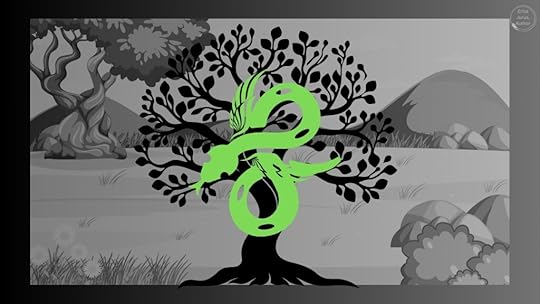
Poet and painter Dante Gabriel Rossetti proposed that the snake in the Garden of Eden was Lilith’s lover, who loaned her its shape so that she could return to Eden and become the temptress of the Tree of Knowledge transgression in disguise.
In my books, I’ve equated her with Leviathan, or Tiamat, a primordial sea serpent dwelling in the watery abyss who at some point is defeated by the god Marduk. But you’ll have to read the books to find out the rest of her story 
October 15, 2024
Edward Gorey, master of the macabre
I suppose fiction writers must seem a little strange to people, spending much of our time inside our heads in imaginary worlds where we make up weird and wonderful tales to entertain you with.
Especially those of us who specialize in the eerie and macabre. We love to twist your expectations and mess with your heads. We get excited when something sends a shiver down our spine, because we know it will do the same to you.
We paint in word pictures so that you can see what we’re seeing, anything from sunny and pleasant to dark and gruesome. But what happens when a writer and an illustrator of the macabre are combined into one person?
Edward Gorey.
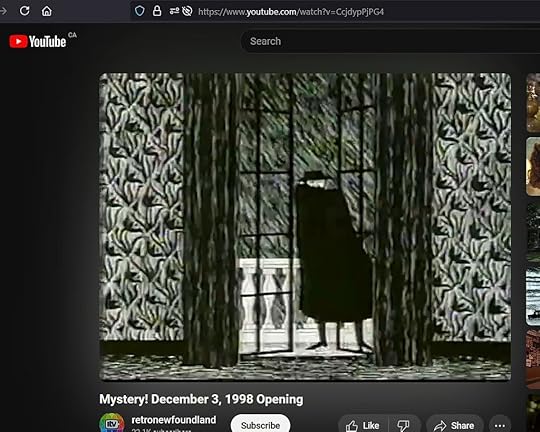 Screenshot of a YouTube post of the PBS Mystery! intro sequence – watch the entire clip at https://www.youtube.com/watch?v=CcjdypPjPG4
Screenshot of a YouTube post of the PBS Mystery! intro sequence – watch the entire clip at https://www.youtube.com/watch?v=CcjdypPjPG4I was first introduced to the weird art of Edward St. John Gorey through PBS Mystery!, which used his animated imagery extensively for its 1980 season, and I became an instant fan. Gorey’s gloomy, imaginative black-and-white artwork was combined into a delightfully atmospheric animated title sequence that introduced the show each week. There were Victorian-looking detectives prowling around a creepy country mansion, a cluster of people in macabre 1930s-era clothing looking like they were attending a party at Dracula’s house, a pair of legs slowly sliding into a murky pond, and lots of stormy weather. Gorey admired mystery writer Agatha Christie, and he put his love of spoofing the genre to good use for this project.
He was born in Chicago, belying his quaintly English drawing style. His father was a journalist briefly, divorced from his natural mother, but his stepmother was Corinna Mura, a cabaret singer and actress whose small claim to fame was in the movie Casablanca as the woman in Rick’s Café Américain who played the guitar while singing the French national anthem.
But Gorey claimed to have gotten his artistic talent from his maternal great-grandmother, Helen St. John Garvey, who was a nineteenth-century greeting card illustrator (although her work was a far cry from Edward’s morbid style).
In an interview with Dick Cavette, Gorey said he first picked up drawing tools at the age of a year and a half; he also taught himself to read a couple of years later. By the age of five he’d read Alice in Wonderland and Dracula, which apparently influenced his burgeoning artistic style. (The former, though a children’s book, is incredibly weird.)
He began making drawings during high school, and studied at the Chicago Art Institute for a single semester before being inducted into the U.S. Army in 1943 and serving in World War II in Utah as a company clerk. After his release, he attended and graduated from Harvard. Moving to Manhattan, Gorey worked in the art department of Doubleday Anchor, where he illustrated many works you’ll recognize, including Bram Stoker’s Dracula and H. G. Wells’ The War of the Worlds.
He’d tried writing novels, unsuccessfully, but that was fortuitous for the legion of fans of his artwork, because he switched to little illustrated novellas. He met Frances Steloff, founder of the Gotham Book Mart, who liked unconventional authors and was willing to carry his books. Eventually his work drew the attention of critic Edmund Wilson, who, in a review in The New Yorker, described Gorey’s work as “surrealistic and macabre, amusing and somber, nostalgic and claustrophobic, poetic and poisoned.”
From there Gorey’s career as an illustrator and sometime author of weird little books took off, but I think it was arguably his artwork for PBS that catapulted him to fame.
If you watch the Dick Cavett interview on YouTube, Gorey seems somewhat uncomfortable in front of the camera, even though in daily life he was not a shy man, striding about in full-length fur coats with hippy-style clothing underneath. He didn’t make the best interviewee – he even admitted that he had a tendency to ramble on – and Cavett didn’t give him enough direction. The interview gets a little interesting about nine minutes in, but I think only the most dedicated Gorey fans will watch the whole thing.
In 1983, Gorey moved permanently to Cape Cod, first to Barnstable and then to a 200-year-old house in Yarmouthport, Massachusetts, that had been build by a sea captain. You can see the interior on YouTube in a short called Visiting the Edward Gorey House. It’s an interesting look at Gorey’s life at home, including a peek upstairs (where the public isn’t allowed) at his studio and his book-strewn television room. He remained there for the rest of his life, eating breakfast and lunch every day at a local diner named Jack’s Outback, which is now filled with Gorey memorabilia. He never married, and although he said he supposed he might be gay, he doesn’t seem to have had any relationships. It sounds like he was asexual more than anything else. There’s also an intriguing article about Gorey and the house on Atlas Obscura.
Instead, he lived with a variety of cats and collected not just books (he had thousands) but all manner of odds and sods like lobster floats as well as a lot of artwork. He said his own art was heavily influenced by the cross-hatch technique of John Tenniel in Alice in Wonderland, and the drawings in Wind in the Willows and the Winnie-the-Pooh books. If you want to see more of Gorey’s artwork, you can watch a collage of the Mystery! title sequences on YouTube, as well as a delightful presentation by Vermont Humanities called Mark Dery on “Edward Gorey’s Morbid Nonsense“.
Another fun site to visit online is the Gorey Store, run by the administrators of Gorey’s Yarmouthport house. There you can browse through his books, artwork turned into all kinds of things to wear and decorate your own home with, even stuff for children (highly ironic, as all the children in his stories invariably met their demise in strange, rhyming ways). I particularly like the Dracula Collection, which is drawn with his usual odd but very cool whimsy.
 Screenshot of Edward Gorey merchandise, specifically the Dracula Toy Theater, on the Gorey Store website, to indulge all your innate Gorey-ness
Screenshot of Edward Gorey merchandise, specifically the Dracula Toy Theater, on the Gorey Store website, to indulge all your innate Gorey-nessIn the interview, Gorey certainly displayed a dry sense of humour that definitely showed up in his artwork, even if he didn’t see it. When a publisher once rejected one of his books because it wasn’t funny, Gorey said, “It wasn’t supposed to be, what a peculiar reaction”.
He probably gave the best description of his work: “My favorite genre is the sinister-slash-cozy. I think there should be a little bit of uneasiness in everything because I do think we’re all really in a sense living on the edge. So much of life is inexplicable. Inexplicable things happen … and you think, if that could happen, anything could happen.”
Explore more about Edward Gorey and his art online at the Vanderbilt University G is for Gorey: The Remarkable Worlds of Edward Gorey exhibit.
October 8, 2024
The Great Art of Light and Shadow
Phantasmagoria and Magic Lanterns
“Fear does not have any special power unless you empower it by submitting to it.”
Les Brown
Terrifying audiences isn’t a modern invention. There’s something about shared horror that has captivated people for several centuries, huddling in a darkened room waiting to be scared out of our wits.
In the 1600s, projectors called Magic Lanterns were invented. They used a concave mirror behind a light source, which would concentrate and direct the light through a transparent slide with an image painted on it. There would then be a lens at the front that was used to focus the image and enlarge it onto some form of projection screen, like a white wall (which people still use today in a pinch). And just like more modern projectors (I still have one), the slide had to be inserted upside down because the lens would invert the image as it passed through.
The Magic Lantern Shows offered horror for a different purpose to begin with. Apparitions of ghosts, witches, devils and demons were used in Europe by the clergy (and, of course, by con men even then), to make the viewers believe they were really seeing the creatures appear, terrifying them in to turning to God (or whatever the con men were peddling).
Originally the pictures were hand painted with black paint, but transparent colors came into vogue, set onto a black-painted background to block out other light so the images could be projected as if they were floating in mid-air.
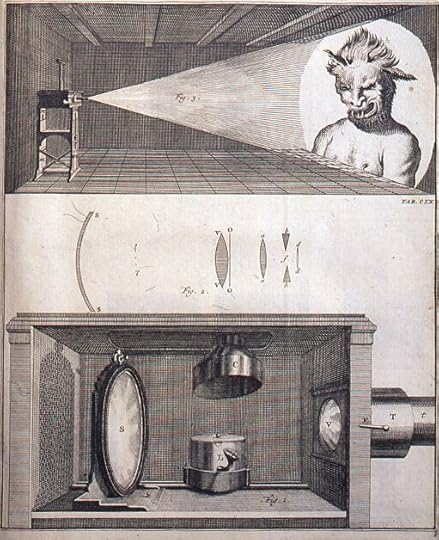 A page of Willem ‘s Gravesande’s 1720 book Physices Elementa Mathematica with Jan van Musschenbroek’s magic lantern projecting a monster. The depicted lantern is one of the oldest known preserved examples, and is in the collection of Museum Boerhaave, Leiden; by Jacob ‘s Gravesande – scan from Physices Elementa Mathematica, Public Domain, https://commons.wikimedia.org/w/index.php?curid=50615645
A page of Willem ‘s Gravesande’s 1720 book Physices Elementa Mathematica with Jan van Musschenbroek’s magic lantern projecting a monster. The depicted lantern is one of the oldest known preserved examples, and is in the collection of Museum Boerhaave, Leiden; by Jacob ‘s Gravesande – scan from Physices Elementa Mathematica, Public Domain, https://commons.wikimedia.org/w/index.php?curid=50615645Oil lamps and candles were the first light sources, but they weren’t bright enough to produce good images. In the late 1700s the Argand lamp was invented, which used a wick surrounded by a glass chimney, burning oil from seals, whales, olives and other vegetables more efficiently and brighter.
Limelight, which used a flame directed by a blowpipe at a cylinder of quicklime, a chemical compound made by burning organic materials like seashells in a kiln, was invented in the 1820s. Such lamps were able to emit a much brighter light, and limelighting was the standard in Victorian theatres for many years. It was prone to starting fires, though, and in the 1860s the electric arc lamp came along that was much safer to use.
The shows were so popular that by the 19th century, itinerant projectionists would travel around with their magic lanterns putting on shows in towns and villages all over the countryside. They had a large stock of slides, with extra sections that could rotate across the main plate to create some special effects. One of the most famous shows was the Rat-swallower, where rats would climb up a bed and crawl into the mouth of a man sleeping in it. You can see a brief clip of this on the Kent Museum of the Moving Image Facebook page.
In the mid-18th century, a coffee shop owner in Leipzig, Germany named Johann Schröpfer converted an old billiards room into a theatre and began offering ‘séances’. His surprised audience didn’t know what was coming. They were assailed by a show that included eerie music, projections on smoke and sound effects, incense, drugs, even electric shocks.
Schröpfer was an interesting person. He claimed to be able to communicate with the spirit world, and that he was the only person who knew the real secrets of Masonry. He reportedly stole some “magical” documents from the Masons, then learned more magic from a German merchant. Schröpfer began performing ‘necromantic’ works not long after that, wherein his collection of followers would have to fast for 24 hours, after which they were served punch and some food that was likely drugged. They would then be dramatically led at midnight, already in an altered state of mind, into a darkened room with an altar draped in black. Schröpfer would appear in a robe and lead them through a series of rituals during which they had to remain sitting at a table or ‘face terrible dangers’. He would typically raise three different spirits, accompanied by uncanny noises. These ghosts could answer his questions, in a hollow-sounding voice.
Actors playing the ghosts, and special effects created with hidden speaking tubes, eerie sounds from a glass harmonica, thunder, and projections onto wavering smoke as opposed to a solid wall, all made the shows so convincing that people believed the spirits were real. Schröpfer was a clever showman, and his performances became so popular that within a few years he’d created an entirely new career for himself. These types of spirit shows became known as “Phantasmagoria”.
Phantasmagoria projectors were mobile, allowing the images to be shown on various types of screens and giving the unnerving illusion of movement. They often used rear projection to make the effect even more mysterious. Multiple projectors allowed a projectionist to switch different images quickly, creating a kind of horror movie filled with ghosts and demons. Many of the phantasmagoria showmen were a combination of scientist and magician, combining technical skills and imagination into drawing the audiences into a complete make-believe world for the duration.
The most famous of them was a Belgian inventor and physicist, Etienne-Gaspard Robert, who became known by his stage name, Etienne Robertson. He’d spent some of his youth in Paris during the height of the French Revolution, and after perfecting his elaborate illusions, returned to Paris to use the macabre atmosphere still permeating the city post-Revolution for ambience. He would stage his shows in an abandoned crypt, letting the natural eeriness inside the tomb set the stage, and then terrify his audiences with all the tricks up his sleeve.
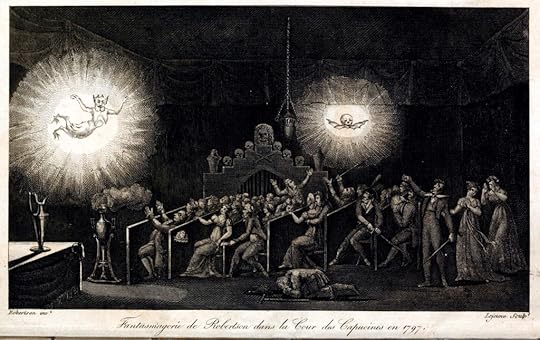 Robertson’s phantasmagoria, Paris, 1797; by Etienne Gaspard Robertson – Internet Archive, Public Domain, https://commons.wikimedia.org/w/index.php?curid=58344135
Robertson’s phantasmagoria, Paris, 1797; by Etienne Gaspard Robertson – Internet Archive, Public Domain, https://commons.wikimedia.org/w/index.php?curid=58344135His philosophy was that “I am only satisfied if my spectators, shivering and shuddering, raise their hands or cover their eyes out of fear of ghosts and devils dashing towards them; if even the most indiscreet among them run into the arms of a skeleton.” After his death, Robertson was buried in the Père Lachaise Cemetery in Paris in a three-storey tomb replete with macabre imagery.
In 1774, the inventor of phantasmagoria, Johann Schröpfer, committed suicide, apparently delusional about his own creations. Perhaps a cautionary tale 
By the 19th century, phantasmagoria shows were big hits in London and throughout the UK, then expanding to the U.S. As technology improved, of course, the old tricks didn’t work as well and the art form eventually dwindled. However, it inspired writer Lewis Carroll in his poems as well as several French painters. Disney attractions like The Haunted Mansion have also used similar special effects, and modern-day film-makers use the same sensory and psychological techniques to continue to scare the pants off millions of satisfied movie-goers, still in darkened rooms where you can’t see what might be sneaking up on you from behind.
If you’d like to get a 2-D sense of what one of these shows was like, the Museu del Cinema presents one on YouTube. Fantasmagoria Llanterna Màgica. Museu del Cinema. In full performance, surrounded by the sights and spine-chilling sounds, they must have been overwhelming. Frankly, I’d love to have seen one of those shows – they sound amazing. In a day and age when CGI and all of the Hollywood tricks weren’t even the gleam in someone’s eye, an atmosphere of sheer fantasy and dread was summoned with a projector and a few creative effects. Millions of houses do it every Halloween, just for the fun of it.
“Figures rise, like phantoms, pale in the dusky lamp light…”
Thomas Carlyle, French Revolution
October 1, 2024
To Hell and Back

There are few true-crime stories as terrifying as the infamous serial killings committed by a figure known only as Jack the Ripper. Amidst decades of speculation, to this day the killer’s identity has never been definitively discovered. “Jack” went on a macabre crime spree in one of the most populated cities in the world yet was never caught – that we know of. That cloud of uncertainty is what inspired Jack’s appearance in my novels, tied in with the supernatural, of course.
Victorian London was a far different place than it is now. By 1825 London was the largest city in the world, crammed with over five million people. While it was a global financial capital with great wealth, it was also a warren of crowded slums and extreme poverty. The very wealthy lived in luxury in the upper-class West End, while their opposites lived in squalor in the East End.

 By Charles Booth – http://www.umich.edu/~risotto/maxzooms/ne/nej56.html (cropped). Original: Charles Booth’s Labour and Life of the People. Volume 1: East London (London: Macmillan, 1889)., Public Domain, https://commons.wikimedia.org/w/index.php?curid=9361611
By Charles Booth – http://www.umich.edu/~risotto/maxzooms/ne/nej56.html (cropped). Original: Charles Booth’s Labour and Life of the People. Volume 1: East London (London: Macmillan, 1889)., Public Domain, https://commons.wikimedia.org/w/index.php?curid=9361611A sizeable immigrant community settled in the East End, including the notorious Whitechapel and Spitalfields districts. Whitechapel housed a lot of factories and foundries, tanneries and slaughterhouses, and other industries that fed the city’s growing demands. People worked in appalling conditions for little pay, most of them largely destitute and looking for any way to support themselves and possibly a family.
One of the theatre actors of the time, Jacob Adler, wrote: “The further we penetrated into this Whitechapel, the more our hearts sank. Was this London? Never in Russia, never later in the worst slums of New York, were we to see such poverty as in the London of the 1880s.”
As a result, many women turned to prostitution. Leading up to the Ripper murders, there were an estimated 1,200 female sex workers in the area.
Petty crime was rampant – pickpocketing and/or garrotting (mugging with strangulation) in particular. There was also a lot of domestic violence that remained largely unreported. In 1863 Parliament introduced floggings to punish violent robbery, while serious criminals were either sentenced to hard labour or getting shipped off to Australia. Murderers were hanged.
Whitechapel, by 1888, had become a crush of people – around 80,000 inhabitants all struggling to make it through another day. Approximately 8,500 people tried to get some sleep at night in the 233 lodging-houses, where, for fourpence they could lie down in a coffin-shaped wooden box, called a coffin bed, and try to stay warm under a tarp cloth. If they couldn’t afford that, for two pence they could rest on a lean-to rope. Over fifty percent of children in the parish died before they were five years old.
Alcoholism and pervasive violence gave rise to waves of social disturbance. The relatively new Metropolitan Police Service, created less than 60 years before, struggled to cope with outbreaks of racism, antisemitism and general antipathy towards the many immigrants. Whitechapel soon developed a reputation as a den of immorality.
Into this fraught atmosphere, gruesome murders made a regular appearance, well before Jack took up the blade. From 1873-4, and again in May 1887 and September 1888, a series of dismembered body parts (torsos, thighs, heads, organs and more) washed up on the banks of the Thames and terrified Londoners for months. They were dubbed the Thames Torso Murders, and the perpetrator was never caught.
There were so many murders, amid the thick fogs of Victorian London that spewed from factories and chimney pots, that when a new spate began in 1888, the police had trouble assigning which belonged to the terrifying killer eventually called Jack the Ripper.
As the Thames flowed through the city, its mists joined the residential and industrial smogs to blanket the narrow, winding streets. At times, travel from place to place was almost impossible, often for days at a time. Street urchins called ‘linklighters’ would carry homemade torches and offer to guide people through the yellow-grey, or even black, miasma for a fee – sometimes to the cosh of a mugger lurking in the darkness.
Imagine now that you’re a ‘working woman’, haunting the streets to make a little money. Dusk has fallen and a fog has rolled in. It’s your last chance to earn enough for some food and a night’s rest, and you can’t afford to be choosy with your customers. Appearing out of the foul-smelling gloom, a carriage pulls up, its horses snorting. The person inside must have enough money to afford such a conveyance, so they’re a good prospect – maybe more than you’re earned all the rest of the day. The door opens, and you step up. Whoever has invited you in will be the last person you’ll ever lay eyes on, screaming with your final breaths.
Such is the image we have of the horrifying murders committed by history’s most infamous serial killer. But the identity of the murderer was never discovered – or at least made public.
 The first page of the “Dear Boss” letter, dated 25 September 1888, By Jack the Ripper – National Archives MEPO 3/142, Public Domain, https://commons.wikimedia.org/w/index.php?curid=249916
The first page of the “Dear Boss” letter, dated 25 September 1888, By Jack the Ripper – National Archives MEPO 3/142, Public Domain, https://commons.wikimedia.org/w/index.php?curid=249916Ever since 1888, both professional and amateur detectives have tried to puzzle out who Jack really was. Whoever he was, and I don’t think we’re even sure of the actual gender, he received his moniker fro a message sent to the Central News Agency of London on September 25 of that year. It was two pages long, written in red ink:
Dear Boss,
I keep on hearing the police have caught me but they wont fix me just yet. I have laughed when they look so clever and talk about being on the right track. That joke about Leather Apron gave me real fits. I am down on whores and I shant quit ripping them till I do get buckled. Grand work the last job was. I gave the lady no time to squeal. How can they catch me now. I love my work and want to start again. You will soon hear of me with my funny little games. I saved some of the proper red stuff in a ginger beer bottle over the last job to write with but it went thick like glue and I cant use it. Red ink is fit enough I hope ha. ha. The next job I do I shall clip the ladys ears off and send to the police officers just for jolly wouldn’t you. Keep this letter back till I do a bit more work, then give it out straight. My knife’s so nice and sharp I want to get to work right away if I get a chance. Good Luck. Yours truly
Jack the Ripper
Dont mind me giving the trade name
PS Wasnt good enough to post this before I got all the red ink off my hands curse it. No luck yet. They say I’m a doctor now. ha ha
The police had received many hoax letters from the supposed killer, and at first the Dear Boss letter was thought to be another – until the body of Catherine Eddowes was discovered in Mitre Square on September 30, with part of the right ear severed. After that, a copy of the letter, along with that of a subsequent postcard on October 1 from “Saucy Jack”, saying that he hadn’t had time to complete the ear job, were widely circulated in the hopes that someone would recognize the handwriting. No one did, but the “Jack” name stuck.
Interestingly, in 1931, a journalist named Fred Best from The Star newspaper supposedly confessed that he and one of his colleagues had written both the letter and the postcard (and other similar hoax messages) in order to foment public interest in the case and boost the sales of the paper. If that was true, did that mean that the actual killer read the letter and decided to emulate the ear-mutilation promised in it? Or did the journalists even collude with their muse?
We’ll never know, it seems. One of the most unnerving aspects of the killings is how the murderer was able to commit extensive and time-consuming murders and then vanish into the bowels of such a well-populated city without discovery. They may have had help, especially if you believe one of the theories that Jack was actually the deranged Prince Albert Victor, the son of King Edward VII.
Mutilated bodies continued to pile up in the loathsome streets of London. The first of the five murders specifically attributed to the Ripper occurred in August, in Buck’s Row, Whitechapel. Mary Ann Nichols had last been seen alive walking in the direction of Whitechapel Road only about an hour before her body was discovered.
A week later, the body of Annie Chapman was discovered near the steps to the doorway of the back yard of 29 Hanbury Street in Spitalfields. Like Nichols, her throat was severed by two deep cuts, and further mutilations had been inflicted on her.
At Chapman’s inquest, someone said they’d seen her standing outside the building just half an hour before, with a “shabby-genteel”, dark-haired man wearing a dark overcoat and a deer-stalker hat (the kind that Sherlock Holmes famously favoured). He had apparently asked Chapman, “Will you?”, and she’d said, “Yes.” Perhaps an invitation to share her favours.
 8 September 1888 edition of the Penny Illustrated Paper depicting the discovery of the body of the first canonical Ripper victim, Mary Ann Nichols By Unknown author – https://www.christies.com/en/lot/lot-6389700, Public Domain, https://commons.wikimedia.org/w/index.php?curid=79437511
8 September 1888 edition of the Penny Illustrated Paper depicting the discovery of the body of the first canonical Ripper victim, Mary Ann Nichols By Unknown author – https://www.christies.com/en/lot/lot-6389700, Public Domain, https://commons.wikimedia.org/w/index.php?curid=79437511 In the early hours of September 30 there were two murders, those of Elizabeth Stride and Catherine Eddowes. Elizabeth’s body didn’t have any mutilations below her neck, so it was uncertain whether it wasn’t the same killer, or if he/she/they had been interrupted before being able to finish. Several witnesses reported seeing her in a man’s company, but the descriptions were all different, making any identification impossible.
Catherine Eddowes, unfortunately, suffered the full treatment. Her body was found in a corner of Mitre Square, a mere three-quarters of an hour after Stride’s body was discovered. The killer had worked fast to find another victim. Eddowes’ mutilations were vicious, from horrific cuts on her face and the characteristic severing of the throat down to her bowels and reproductive organs. The murders of these two women became known as the “double event”.
A chalk inscription upon a wall after Eddowes’ murder, above where her bloodied apron was found, became famous: “The Juwes are The men That Will not be Blamed for nothing.” Such graffiti were commonplace in Whitechapel, and, fearing that it might incite antisemitic riots, Police Commissioner Sir Charles Warren ordered the writing washed away.
On October 16, the Whitechapel Vigilance Committee, a group of local civilian volunteers formed by sixteen tradesmen from the Whitechapel and Spitalfields districts worried that the killings were affecting businesses in the area, received a macabre gift. A letter captioned “From Hell” at the top arrived in a box along with the left half of a human kidney. In the letter, the writer claimed that he “fried and ate” the other half. Catherine Eddowes’ left kidney had been cut out; the one received by the Vigilance Committee was examined and found to be human, but nothing else could be determined. The writer signed off with “catch me if you can”.
 A photographic copy of the now-lost “From Hell” letter, postmarked 15 October 1888, by Unknown author (credited to Jack the Ripper) – Original in the Records of Metropolitan Police Service, National Archives, MEPO 3/142; this facsimile from http://www.casebook.org/ripper_letters/, Public Domain, https://commons.wikimedia.org/w/index.php?curid=249871
A photographic copy of the now-lost “From Hell” letter, postmarked 15 October 1888, by Unknown author (credited to Jack the Ripper) – Original in the Records of Metropolitan Police Service, National Archives, MEPO 3/142; this facsimile from http://www.casebook.org/ripper_letters/, Public Domain, https://commons.wikimedia.org/w/index.php?curid=249871 The final ‘official’ victim was Mary Jane Kelly, and the most savagely destroyed. Her body was discovered lying on the bed in her room in Spitalfields, on the morning of November 9. Even her face had been “hacked beyond all recognition”, and body parts removed to decorate the room with. The heart was missing from the crime scene, a curious detail. Ashes in her fireplace seemed to suggest that the killer had burned some things to light the room for his work, hot enough melt the solder between a kettle and its spout, causing the spout to fall into the grate. You can see the police photo of the body on Wikipedia if you have the stomach for it.
All of the murders were incredibly brutal, as if the Ripper acted out of great anger, great obsession, or, more disturbingly, great pleasure. The victims were all prostitutes; whether the Ripper targeted them for their profession, or their easy access, is unknown.
Then the murders ceased, all of a sudden. There were other possible similar murders in various locations, but no concrete connection to the famous five was ever established.
Most of the police files relating to the investigation were destroyed in the Blitz in WW2, but the surviving files show that the investigation was extensive. Forensic material from the crime scenes was collected and examined, house-to-house inquiries were made throughout Whitechapel, over 2000 interviews were conducted and more than 300 people were investigated. After the “double murder”, the Commissioner of the City Police offered a reward of £500 for the arrest of the Ripper.
Never solved, the file was officially closed in 1892, and like all unsolved mysteries, it continues to haunt the public imagination. The list of suspects is substantial, including Queen Victoria’s personal physician, William Gull. At the time, Inspector Macnaghten of Scotland Yard believed that a barrister named Montague John Druitt was the killer; the sole ‘evidence’ seems to have been his unfortunately turning up drowned in the Thames shortly after the murders ceased.
London dockworkers were under suspicion because they worked near Whitechapel. A scrap metal merchant named James Maybrick allegedly left a diary confessing to the murders, which he’d committed on a rampage after discovering his wife had been unfaithful. The diary stated that: “I give my name that all know of me, so history do tell, what love can do to a gentle man born. Yours truly, Jack the Ripper.”
There have been numerous theories as to the Ripper’s true identity – even the writer Lewis Carroll, of Alice in Wonderland fame, has come under some weird scrutiny in modern times.
 First edition (publ. Gemini Press) By https://www.abebooks.co.uk/servlet/BookDetailsPL?bi=30349099103, Fair use, https://en.wikipedia.org/w/index.php?curid=61183909
First edition (publ. Gemini Press) By https://www.abebooks.co.uk/servlet/BookDetailsPL?bi=30349099103, Fair use, https://en.wikipedia.org/w/index.php?curid=61183909Carroll was sent, at the age of 12, to a boarding school, and wrote home about how unhappy he was there. In 1996 a writer named Richard Wallace decided that Carroll and his colleague Thomas Vere Bayne were responsible for the Jack the Ripper murders. He based it on three things: that early schoolboy upset, Carroll’s fondness for wordplay, and the fact that Carroll would have been working on two of his works, one of which was The Nursery “Alice”, an adaptation of Alice’s Adventures in Wonderland for younger readers, during the Ripper murders.
Wallace’s notion was that, during his time at the boarding school, Carroll was physically abused at the school and had a psychotic break that stayed with him. Carroll then apparently took it out as an adult on the women of Whitechapel and hid messages to that effect in his books, as well as some of his letters.
Here’s a sample of Wallace’s deductions: a sentence to Carroll’s brother Skeffington, “My Dear Skeff: Roar not lest thou be abolished”, was believed to actually read (letters rearranged): “Ask mother about the red lion: safer boys fled.” The “red lion” was a game played at Carroll’s boarding school, one that Wallace suspects was sexual in nature and left Carroll burning with fury toward his mother and father, who had sent him to the school, and toward society at large.
Wallace declared that in The Nursery Alice, Carroll confessed to the gruesome murders. He ‘deciphered’ one of the passages as:
“If I find one street whore, you know what will happen! ‘Twill be off with her head!”
There were a lot more stretched ‘confessions’, in Wallace’s mind. The fact that the writing of Carroll’s diary entries didn’t match the Ripper’s letters to newspapers didn’t discourage him—someone could have written them on his behalf.
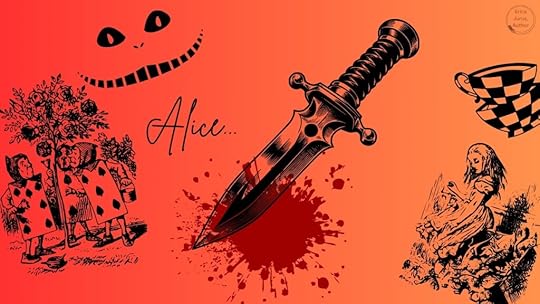
After Wallace’s research was discussed in a 1996 issue of Harper’s magazine, two readers took the time to point out that the opening paragraph of the book:
This is my story of Jack the Ripper, the man behind Britain’s worst unsolved murders. It is a story that points to the unlikeliest of suspects: a man who wrote children’s stories. That man is Charles Dodgson, better known as Lewis Carroll, author of such beloved books as Alice in Wonderland.
could be reordered to offer his own confession:
The truth is this: I, Richard Wallace, stabbed and killed a muted Nicole Brown in cold blood, severing her throat with my trusty shiv’s strokes. I set up Orenthal James Simpson, who is utterly innocent of this murder. P.S. I also wrote Shakespeare’s sonnets, and a lot of Francis Bacon’s works too.
(Source: On the time Lewis Carroll was accused of being Jack the Ripper.)
Wallace never responded – indeed, how could he? His spurious theory had just been blown out of the water, not that it was ever taken very seriously anyway.
In 1888, the police believed that the Ripper was living in Whitechapel himself, with intimate knowledge of the area’s back alleys and hiding places that allowed him to quickly disappear after each murder. It was a sound-enough theory, but impossible to track; the population of the Whitechapel district was largely transient and often used aliases. It would have been easy for someone to fade into the background.
Several theorists believe that “Jack the Ripper” was actually several killers, either as some kind of cabal, or just unconnected nutbars. There was also a theory that the Ripper was a woman, not a man – possibly Mary Pearcey, who’d used a method similar to the Ripper’s to murder of her lover’s wife and child. She was convicted and hanged in 1890.
Police surgeon Thomas Bond to give his opinion on the extent of the murderer’s character and surgical knowledge. It’s the earliest known offender profile in criminal history. Bond didn’t think that the murderer had any kind of special anatomical or scientific knowledge, or even “the technical knowledge of a butcher or horse slaughterer”. He believed that the Ripper must have been a man of solitary habits, subject to “periodical attacks of homicidal and erotic mania”, and that “the homicidal impulse may have developed from a revengeful or brooding condition of the mind, or that religious mania may have been the original disease but I do not think either hypothesis is likely”.
Although there was no evidence of sexual contact with any of the victims, some psychologists suggest that the ‘penetration’ with a knife and the sexually degrading positions the women were left in indicates sexual pleasure from the attacks.
Modern DNA analysis on the Ripper letters has been inconclusive, as they’ve been handled many times and are too contaminated. There’s no other concrete surviving evidence to apply forensics to.
There are far too many suspects, both at the time and over time, to include in this blog. I don’t believe we’ll ever know the identity of Jack the Ripper, unless something remarkable from the past comes to light.
Personally, I love the suggestion in the episode of the original Star Trek series called Wolf in the Fold. (No spoilers here: watch the very eerie episode to see for yourself.)
The From Hell letter inspired me to imagine my own theory of what could turn a man into such a monster, and you can read that excerpt from Book 1: Through the Monster-glass, on this site on the Bonus Materials page (all materials are under my copyright and may not be distributed or re-used without contacting me for permission). Let me know what you think as we kick off this spine-chilling month; that’s not the final reference to the Ripper killer in my trilogy.
September 24, 2024
Mysticism, Divination & Tarot

We’ve reached that point of the year when the world balances between 12 hours of day and 12 hours of night. This year it took place on Sunday, September 22. From hereon in, until the Winter Solstice, the nights will get longer, which creates a magical feel to our days. In my Chaos Roads novels, the 4 turns of the Wheel are almost the only days when the Fae can cross over into human lands, after Balthazar the Magus did something to prevent their more frequent incursions to mess with humanity.
For me, fall begins at the start of September, a feeling I’ve carried since I began going to school, but from the Equinox onward, we draw closer and closer to Samhain, aka Halloween, when the barriers between all worlds are said to be the thinnest, and all kinds of creatures can cross over to create mischief.
The thoughts of those of us who write eerie stories naturally turn to magic and the supernatural, so that we can entertain fellow devotees of the season’s atmosphere (although, really, we’re entertaining ourselves first and foremost  ). I have great fun with my autumn blogs, exploring all things esoteric to encourage you to think about possibilities.
). I have great fun with my autumn blogs, exploring all things esoteric to encourage you to think about possibilities.
This week we’re taking a look at Divination, a way to gain insight into a question, or the future, using rituals defined as “occult”. Those rituals fall outside (and sometimes far outside) science and certain religious practices, including Christianity. The Bible, in Deuteronomy, expressly forbids such rituals:
Deuteronomy 18:10–12
No one shall be found among you who makes a son or daughter pass through fire, or who practices divination, or is a soothsayer, or an augur, or a sorcerer, or one who casts spells, or who consults ghosts or spirits, or who seeks oracles from the dead. For whoever does these things is abhorrent to the Lord; it is because of such abhorrent practices that the Lord your God is driving them out before you.
However, there are numerous times in the Bible where people “cast lots” to determine outcomes. Lots could be anything from dice to stones to slips of paper, and the practice had a divinatory name, cleromancy. It seems there was a fine line between inappropriate augury and the acceptable kind, which was said to reveal the Divine Will.
When I was a kid, Halloween parties routinely featured the thrill of holding a séance in a darkened room, and Ouija boards were widespread toys. It was all considered harmless fun (until The Exorcist came out).
So I may be in some trouble. I’ve always been fascinated by Tarot cards.
 My first Tarot Deck – by E. Jurus, all rights reserved
My first Tarot Deck – by E. Jurus, all rights reservedTarot cards, the colourful, mysterious fortune-predicting cards regularly invading horror stories and carnival booths.
I bought my very first deck on a class trip to Ottawa, during the late sixties when mysticism was really popular. Every shop burned incense, had dark velvet curtains, and posters about Ages of Enlightenment, Egyptian mysticism and expanding our mind’s inner eye.
I spent the entire train trip back home reading the cards for my classmates, even though I had to refer to the instruction booklet every time. It was the most popularity I’d ever experienced. The net result was that a lot of my classmates thought I was a witch throughout high school.
There have never been any signs that I’m a medium – none – which is fine by me, but I did become very good at reading people’s cards, to the point of uncanniness. Perhaps a lot of intuition, although a psychic doing a reading for a family member, that I just happened to sit in on, told me that I have a blue and purple aura. That meant that I’m psychic in some form, but definitely no clairvoyance or precognition. Nevertheless, way back then, when someone asked me what I’d do if I saw something really bad during a reading, I realized I didn’t want to ever run into that situation, and I packed my Tarot deck away.
The use of divination goes back to ancient times. Kings, emperors, generals and common folk often consulted famous Oracles, such as those at Delphi in Greece and Siwa in Egypt. The oracles were mystical seers who would interpret the wisdom of the gods. But augury could also be performed by priests/shamans who could read signs and portents. Animal sacrifice was often involved.
Astrology, the reading of meaning to the movements of celestial bodies, dates back more than two millennia. Most ancient cultures studied the night skies extensively, trying to make sense of earthly events. The practice was a precursor to astronomy, just as medieval alchemy eventually led to modern chemistry, and many people still consult astrologers to this day. (When hubby and I subscribed to a printed newspaper, I liked to read my horoscope the following day, to see if the predictions were true  – generally not, but I did realize that wasn’t the best medium for a proper reading.)
– generally not, but I did realize that wasn’t the best medium for a proper reading.)
Babylonian astrology was the earliest recorded organized system of astrology. The Babylonians believed that the gods revealed themselves through the planets and stars that they were associated with. Marduk, the civilization’s patron god, was tied to the planet Jupiter, for example. Evil omens ascribed to that planet were interpreted as Marduk’s displeasure, and the people needed to find ways to appease him to prevent further disaster.
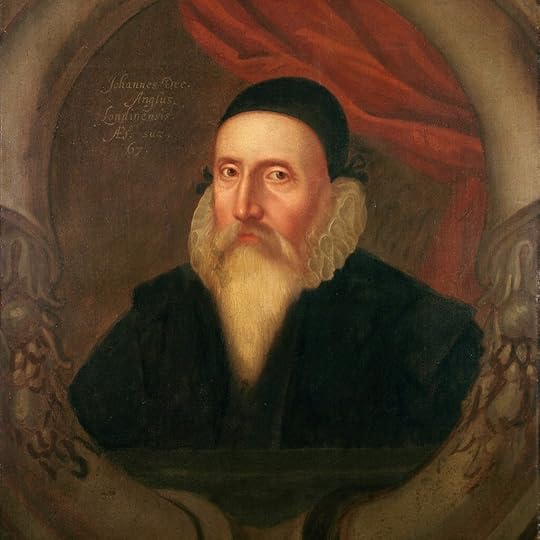 portrait of John Dee: According to Charlotte Fell Smith, this portrait was painted when Dee was 67. It belonged to his grandson Rowland Dee and later to Elias Ashmole, who left it to Oxford University. By Unidentified painter – Scan from site of National Maritime Museum, Greenwich http://www.nmm.ac.uk/, Public Domain, https://commons.wikimedia.org/w/index.php?curid=62082
portrait of John Dee: According to Charlotte Fell Smith, this portrait was painted when Dee was 67. It belonged to his grandson Rowland Dee and later to Elias Ashmole, who left it to Oxford University. By Unidentified painter – Scan from site of National Maritime Museum, Greenwich http://www.nmm.ac.uk/, Public Domain, https://commons.wikimedia.org/w/index.php?curid=62082John Dee was famously the court astrologer for Queen Elizabeth I. He was an astronomer, mathematician and teacher, as well as an alchemist and occultist. Prior to his work for Elizabeth, he’d cast horoscopes for both Queen Mary, who was later accused of treason, and Elizabeth while she was still a princess. When Elizabeth succeeded to the throne, Dee became her advisor, even choosing her coronation date.
Most people are familiar with Chinese astrology, in which certain birth years are associated with a particular animal – dog, dragon, goat, horse, monkey, ox, rabbit, rat, rooster, snake or tiger. They have representative elements: Yin or Yang aspects of Earth, Fire, Metal, Water and Wood. My element is Yin Fire, which does describe my personality fairly well (but not completely) – fact-oriented, love of learning, a desire to nurture and illuminate others, explorer. Of course, the system is much more complex than that, but the imagery and the celebration of Lunar New Year have become enormously popular in Western culture.
Cartomancy, the use of decks of cards to foretell the future, appeared some time in the 14th century. It was often done with standard playing cards, but special decks, “tarocco” or “tarocchi”, were created in Italy for playing card games, and they began to be used by European occultists. The elaborate artwork on Tarot cards has always imbued them with a special aura that hasn’t been lost on fantasy and horror writers.
In Tarot decks, there are four ‘suits’, analogous to the four suits of standard decks, but called and decorated as Swords, Cups, Batons and Coins – 56 cards total.
 Le Bateleur (aka The Magician) from Oswald Wirth’s 1889 tarot deck; By Oswald Wirth, a Swiss artist, author and occultist – The British Museum, Public Domain, https://commons.wikimedia.org/w/index.php?curid=92756097
Le Bateleur (aka The Magician) from Oswald Wirth’s 1889 tarot deck; By Oswald Wirth, a Swiss artist, author and occultist – The British Museum, Public Domain, https://commons.wikimedia.org/w/index.php?curid=92756097Instead of court cards (Jack, Queen. King), there are 22 special cards, without suits, referred to as the Major Arcana (i.e. ‘greater secrets), whose very names and depictions lend a deep mystical ambience to a reading:
Death – in the guise of Grim Reaper, signifying major change in one’s lifeJudgement – sometimes with the angel Metatron at the Last Judgement – could mean judgement, absolution, rebirth, even karmaJustice – as in ‘scales of’; usually represents equity, triumph of right over wrongStrength – for some reason, usually a woman leaning over a lion; generally courage, power, action, successTemperance – one of the three Virtues, usually shown by a figure pouring liquid between two cups; as you might expect, it represents moderation, frugalityThe Chariot – exactly what it sounds like, and symbolizing trouble, war, vengeance, and perhaps triumphThe Devil – arguably the most frightening card, it represents use of force, violence, possible fatality, but not always evilThe Emperor – guy on a throne, exuding authority, structure, establishmentsThe Empress – female counterpart with crown and sceptre, with contradictory meanings depending on adjacent cards, from fruitfulness and initiative to doubt, ignorance, clandestine activitiesThe Fool – usually a beggar or a vagabond as opposed to a jester; he represents everything that goes with his name: folly, extravagance, intoxicationThe Hanged Man – a man hanging upside down by one ankle from a branch or gallows; indicates wisdom, intuition, prophecy, possibly trials and sacrificeThe Hermit – an old man, cloaked, carrying a lantern which could be the Lamp of Truth; he represents prudence, but also the opposites of corruption, lies, even treasonThe Hierophant – originally the Pope, a pontiff who’s the Teacher of Wisdom; he is the interpreter of sacred mysteries, and symbolizes goodness and mercy, but also alliance, captivity and servitudeThe High Priestess – a robed woman who might have variously depicted the legendary Pope Joan, the goddess Hathor, Isis, the Virgin Mary…representing mystery and secrets, wisdom, the future unrevealedThe Lovers – Adam and Eve-like figures in front of the Tree of Knowledge; they represent attraction and love, and maybe trials overcomeThe Magician – aka the Magus (an ancient term for a person of occult knowledge), often holding a baton or wand; associated with the planet Mercury, he is the conduit between the physical and spiritual, fulfilling potential, but also influenced by willpower, passion, rageThe Moon – in a night sky, with a wolf and a dog howling; it indicates danger, deception, hidden enemies, occult forces, terrorThe Star – a large star in the sky, beneath which a naked woman kneels by a pool of water, pouring more in from a jug; a very positive card (unless reversed) that symbolizes hope, enlightenment, bright prospects aheadThe Sun – a blazing sun shining down on an infant riding a white horse; this is considered the best card in the Tarot, showing happiness, vitality, self-confidence and successThe Tower – an unnerving card showing a tower destroyed by lightning; as you might guess, it’s associated with crisis, danger, destruction, ruin, unforeseen catastropheThe World – depictions of the cycle of life, sometimes an ouroboros (snake biting its own tail), or a woman dancing above the Earth; another card of change, it could mean a voyage, a relocation, emigration, or flight, with possible successWheel of Fortune – the classic wheel in the sky, six or eight spokes, and sometimes with riders; it represents destiny, luck or fortune, successNow the tricky part is if any of these cards are reversed (upside down) through shuffling, which then imparts their opposite symbolism.
According to Tarot readers, the cards are a tool for personal discovery and self-care, not for fortune-telling as they’ve been commonly depicted. The readings allow the seeker to discover forces and influences around them, and to make decisions based on that information.
The 56 Minor Arcana cards represent our thoughts, feelings, experiences, and beliefs. They relate to the more specific daily challenges of everyday life and our current situation.
The Minor Arcana cards are made up of four tarot suits that focus on different parts of our lives:
Wands: the Fire Element. The Wands represent energy, creativity, passion and sexuality.Cups: the Water Element. Emotions, feelings and intuition are all covered by this suit.Swords: the Air Element. The Swords represent our thoughts, words and actions.Pentacles: the Earth Element. Dealing with the material world, Pentacles offer guidance on our career paths, finances and even material possessions.It’s a lot to remember, and I never passed beyond having to consult a book to decipher a seeker’s layout.
My original deck is a Rider Waite Smith Tarot. It was first published by the Rider Company in 1909, based on the instructions of a mystic named A. E. Waite, a member of the Hermetic Order of the Golden Dawn (a secret society working with occult practices and metaphysics in the late 19th and early 20th centuries). The cards were illustrated by another member, Pamela Colman Smith. The deck has been published in numerous editions; something like 100 million copies have been sold world-wide.
My cards have a variation on the classic Rider illustrations, but the names are in French, probably because of Ottawa’s proximity to Quebec. I knew what they meant, as schools had introduced French study into elementary schools by that time.
Along with Tarot cards, I was fascinated by all forms of mysticism and the supernatural, which meant that I naturally fell under the spell of speculative fiction, like that of H.P. Lovecraft, and the first supernatural television soap opera, Dark Shadows. They were all big influences on my own writing over the decades, and why I veered toward Urban Fantasy rather than the High Fantasy of Lord of the Rings (although I loved that trilogy and made a point of visiting movie-set Hobbiton in New Zealand when we were there).
Whatever you may believe about Tarot, or astrology, or the occult, I think the world is a more interesting place if there’s the possibility of a little magic in it. Just skip the Ouija board.
September 17, 2024
Tea and a Mystery – the Lord Peter Wimsey series

I’ve always loved stylish mysteries, the ones with piles of atmosphere. British mysteries from the Golden Age of Detective Fiction, set in the 1920s and 30s, or just about anything in a foreign setting – armchair travel with a thrill.
Agatha Christie’s more exotic stories have been a long-standing favourite. The 1978 film version of Death on the Nile cemented my determination to visit Egypt in person one day. I thought it would be fantastic to wind up on just such a cruise myself, sashaying along the decks in beautiful clothes while Hercules Poirot brilliantly exercised his little grey cells.
Plus I just love the era, especially when cocktails and glamour mixed with mansions and tea trays, and murder stained dark alleys from New York City to Shanghai to small British towns.
When I discovered the novels of Dorothy Sayers, with her suave, wealthy amateur detective gallivanting around in his classic Daimler car, I was in like a blood-soaked shirt.
We’re introduced to Lord Peter and his privileged lifestyle in Whose Body?, set in 1921 just a handful of years after World War I. He seems an amiable, piano-playing aristocrat who dabbles in solving crimes.
He’s a member of the Savile Club, a prestigious men’s club in London. He lives at 110a Piccadilly, a block of “new, perfect and expensive flats” in the city. He has a “well-trained” butler named Bunter, and as the story begins, Wimsey is on his way to a sale to buy some several expensive first-edition folios (manuscripts), dressed in a “frock-coat” and top hat, from which he feels he needs to change into a less fancy grey suit to go and investigate the body in the bath.
Sayers describes him as having grey eyes and tow-coloured hair (very pale blond), a long receding forehead and long narrow chin, not particularly handsome. He wears a monocle, carries a Malacca walking-stick with a heavy silver knob on the top, affects an air of frivolity that hides an extraordinarily keen mind, and has enough charm to lull all kinds of interviewees and suspects. Later in the series, in the book Gaudy Night, after Peter has fallen in love with a woman he saved from hanging, Harriet Vane, the Dean of Harriet’s old college at Oxford asks about Lord Peter’s current investigation:
“ ‘Will he lay traps all evening for us to walk into?’
‘If he does, he will display all the mechanism in the most obliging manner.’
‘After one is inside. That’s very comforting.’
‘That,’ said Miss de Vine (one of the resident scholars), brushing aside these surface commentaries, ‘is a man able to subdue himself to his own ends. I should be sorry for anyone who came up against his principles – whatever they are, and if he has any.’ “
Wimsey isn’t a ‘peer of the Realm’, as he’s the second son in his family. The title of Duke belongs to his older brother Gerald, a stolid and not-too-bright noble. Gerald’s snobbish wife isn’t fond of Peter, but Wimsey does get along with his charming mother and left-leaning younger sister Mary.
Peter was educated at Eton College, of course, as was any young aristocrat, and then at Oxford as part of Balliol College. He was a superb cricketer, and very bright – so much so that when he later serves in World War I, he’s recruited for intelligence work.
When he’s not out solving crimes, Lord Peter spends mornings in a peacock-patterned bathrobe, reads the Daily Mail “before a blazing fire of wood and coal”, and eats excellent food with “incomparable” coffee made for him by Bunter. His friend in Scotland Yard, Charles Parker, later to become his brother-in-law, enjoys visiting him for the creature comforts he himself can’t swing on a detective’s salary.
Dorothy Sayers once said that, in inventing the character of a wealthy man who begins solving crimes as a hobby, she gave him the money to buy things she couldn’t at the time, when she was struggling financially.
“When I was dissatisfied with my single unfurnished room I took a luxurious flat for him in Piccadilly. When my cheap rug got a hole in it, I ordered him an Aubusson carpet. When I had no money to pay my bus fare I presented him with a Daimler double-six, upholstered in a style of sober magnificence, and when I felt dull I let him drive it. I can heartily recommend this inexpensive way of furnishing to all who are discontented with their incomes. It relieves the mind and does no harm to anybody.”
Over the course of the books, Sayers revealed more and more about her detective, from his many love affairs (always politely ended with an expensive gift), to his post-traumatic stress from serving as an officer in the trenches in the Great War, where he met Bunter and formed a lasting friendship. After the war ended, while Wimsey struggled to cope with his “shell-shock”, as it was referred to at the time and little understood, Bunter found his former Major and pressed himself into service to care for him. After Wimsey recovered and took up his hobby, Bunter provided superb photography skills and an entrée into the world of below-the-stairs staff for additional investigation as needed.
Sayers’ novels aren’t renowned for challenging puzzles, but she was innovative at the time for writing well-rounded characters with complex motivations. She became known as one of the four “Queens of Crime” of the Golden Age, along with Margery Allingham, Agatha Christie and Ngaio Marsh.
Dorothy was the only child of the chaplain of Christ Church college at Oxford. When she was four years old her father accepted the post of rector of a small country town, which offered a better stipend and a large rectory with considerably more living space, but was more isolating. Without any siblings or friends around, and educated at home, she grew up reading a lot of her father’s extensive library. She won a scholarship at nineteen that allowed her to study modern languages at Somerville, an all-women’s college at Oxford.
She was a distinguished student with a disposition to writing, co-founding the cheekily-named Mutual Admiration Society, where female students could read and critique each other’s work. She was awarded first-class honours upon graduation, but couldn’t receive a formal degree because at the time Oxford didn’t confer them on women. Five years later, when the university changed its rules, she was among the first women to get one.
During her time at Oxford, she was attracted to fellow student Roy Ridley, whose appearance and manner she later used for her famous character, Lord Peter.
After graduating Sayers, published two volumes of poetry, and taught modern languages at Hull High School for Girls, which she didn’t like particularly. In 1917 she began working back in Oxford with publisher and bookseller Basil Blackwell, of the still-fabulous Blackwell’s Bookstore. A friend of the time period described her as having an enormous amount of knowledge about a wide variety of subjects, which eventually made its way into her novels.
Following an affair in France and another in London, during a time when that sort of thing was frowned upon (which formed the basis for the murder charge levied against her character Harriet Vane, along with the condemnation of the era), she took a job as a copywriter at Britain’s largest advertising agency, and used those experiences to write one of her least-favourite novels, but one of my personal favourites, Murder Must Advertise.
When she wasn’t at work, Dorothy tried her hand at writing fiction – detective novels, specifically, which were popular. She studied the best books in the genre at the time, and decided she could make some money writing novels herself. According to another crime novelist, J. I. M. Stewart, she “mastered the art of giving a pleasant literary flavour to her stories”.
Whose Body?, was published in 1923 to mixed reviews. Critiques included that the aristocratic Wimsey was unconvincing as a detective, that the story was too sensationalist, that it was a clever enough mystery but crudely drawn. Not everyone felt that way, though, and she became a successful mystery writer whose legacy has lasted to our modern era.
In 1930 she published Strong Poison, her second novel that year, introducing the character Harriet Vane, whom Wimsey fell deeply in love with while proving innocent of a murder charge. Harriet was a strong, independent mystery writer, also educated at Oxford, and has been described as Sayers’s alter ego. In the book, Wimsey proposed to Harriet, who refused him because she felt that gratitude wasn’t a good way to start a relationship.
Sayers originally planned for Wimsey to marry Harriet at the end of the book and retire from his detecting hobby, thereby ending the series. However, needing the money, she wrote another five Wimsey novels.
In them, as the aristocrat continues to pursue the “blue-stocking” (an old-fashioned term for a educated, intellectual woman, as such women were viewed at the time), she begins to see more of the man beneath the sophisticated veneer, and in Gaudy Night, when she calls on Lord Peter to help her solve increasingly more dangerous events at her beloved alma mater, she realizes that she’s fallen in love with him as well.
My other top favourite Wimsey story is Busman’s Honeymoon, in which Harriet and Peter get married and go down to a farmhouse called Talboy’s that he bought her as a gift. In typical fashion, they find a dead body, and the mystery of its killer to solve. The book is all about the minutiae and charm of old English country life (in between crime-solving) and two strong personalities learning to live with and love each other through a trying time.
Busman’s Honeymoon was the last full Peter Wimsey novel, sadly. Harriet and Peter made brief appearances afterwards in short stories, mentioning their ongoing passion and their three sons. Her novels read a bit politically incorrect now, as she of course included prevailing attitudes about minorities, but many people feel she treated those characters with more sympathy than most other writers of the day.
In her time, she was a founder member of the Detection Club, a group of British mystery writers, that still exists today, and once included Agatha Christie and G. K. Chesterton. The club holds regular dinner meetings in London, with an initiation and a tongue-in-cheek oath written by Sayers herself:
“Do you promise that your detectives shall well and truly detect the crimes presented to them using those wits which it may please you to bestow upon them and not placing reliance on nor making use of Divine Revelation, Feminine Intuition , Mumbo Jumbo, Jiggery-Pokery, Coincidence or Act of God?” (Originally it also included other common cliches of the time: “to observe a seemly moderation in the use of Gangs, Conspiracies, Death-Rays, Ghosts, Hypnotism, Trap-Doors, Chinamen, Super-Criminals and Lunatics, and utterly and forever to forswear Mysterious Poisons unknown to Science”.)
Dorothy continued to write, including collaborative plays, and began on what’s considered a definitive translation of poet Dante’s Divine Comedy, finishing the first two of his books but passing away during her work on the third.
Her Wimsey novels have been made into movies, stage productions, and a well-produced series that aired on PBS Mystery in America. In 1973 a small planet was named after her, and in 2000 English Heritage installed a blue historical plaque at 24 Great James Street, Bloomsbury, where she lived between 1921 and 1929. Several biographies have been written about her.
For me, the mysteries generally took a back seat to the atmosphere and the window into an intriguing bygone era, even as they were often lightly satirical: of the dwindling era of aristocrats with magnificent estates and their lifestyle, which even they recognized was fading; of the hard-partying post-war generation; of all the daily details of a time not intimately captured on social media.
Lord Peter Wimsey was as much an escape for Dorothy as he is to generations of readers. I came across one short biography of her speculating that she fell in love with her own protagonist, who became increasingly charismatic and sympathetic throughout the series. Perhaps he was her ideal man, full of intelligence and intellectual conversation whom she would have loved growing old with.
Read the books for their wonderful ambience, and a portrait of a time of great change sandwiched between two massive wars.
September 10, 2024
Dreaming big

Yesterday was National When Pigs Fly Day.
It’s a day to take joy in silliness, but more importantly, it’s a celebration of possibilities. I love this description from one of the many online day calendars: “It reminds us that anything is possible if we are brave enough to take risks and pursue our dreams, no matter how farfetched they may seem. “
For decades, I nurtured a dream of writing novels. I can’t tell you how many times I jotted hand-written notes and partial chapters in workbooks, and magical ideas on scraps of paper as they came to me. I had a drawer full of them. (Now I put them in my phone.)
But I didn’t study writing in university, or become a journalist. I did, however, have passion to fuel me. For all that time, I read good writing and bad, and studied a lot about crafting novels. Still, it seemed a dream out of reach. I had full-on ‘imposter syndrome’, even though I’d been writing business articles and marketing copy for a local college I worked at, and a fledgling blog.
I got better with practice. This is a really important point. No one magically becomes an expert on the first try, or the second, or even the tenth. Becoming good takes time, and dedication.
In 2020 I retired from my full-time job just as the pandemic lock-downs began. That was a tough time for all of us, but my hubby was still going to work as an ‘essential worker’, whereas I was stuck at home for the most part. Weekly grocery excursions, all masked-up and hand-sanitizer equipped, and walks around a botanical garden, in the fresh air and mask-free, kept my sanity intact.
By the autumn, I was really at loose ends, but National Novel Writing Month was approaching, and I thought that year I’d really give it a crack. After all, what did I have to lose?
That event is all about getting words and a plot out your head and onto ‘paper’, because no matter how much you may wish to write a book, nothing can happen until you stop dreaming and start writing. The task for the month of November is to do your best to write 50,000 words. They don’t have to be great words – that comes later in the editing process.
One of the negative ideas that had been holding me back was: What if I spend a year writing a book and it’s crap? I’ll have wasted all that time. Well, I figured that spending a month on it wasn’t too much to invest. At least I’d have given it a shot, after decades of fiddling around. I had a basic plot for a trilogy, and I knew where each book would begin and end.
The other negative idea was: What if I suck at writing? I truly had no idea if I could fill out a complete book, or if I could write good dialogue, or convey my ideas adequately. The answer to that was: Just try writing the damn thing!
If, at the end of a month, I had a pile of garbage, at least I’d finally done it. But, if I wrote 50,000 words that were decent, then I’d have the makings of my first novel.

That November was lots of work – there’s no softening the fact that you have to produce around 3,000 words a day – but exhilarating. As I wrote about my protagonist, Romy Ussher, and the strange world she found herself drawn into, the plot just spooled itself out like a movie in my imagination. My characters began to live in my head, and to speak their minds. Sometimes they surprised me, which was a delight.
By the end of the month, I’d produced 50, 520 words. OMG, I’d done it. The words were good, I thought. So I kept going, caught up in Romy’s journey. Frankly, I was having a blast.

I worked hard at my novel, in spurts. Sometimes I was stuck on a plot point, but if I let it percolate in my head for a couple of days, invariably the answer came to me. To a large extent, I let the characters do what they wanted to do and just wrote it down.
On July 31, 2021, I finally typed “The End”. It was a little surreal. I’d actually written my first novel. My hubby and I cracked open a bottle of champagne. Then, as instructed by NaNoWriMo, I stepped away from the draft for a month.

Editing began with returning to the book with fresh eyes. I love writing on a computer because it’s easy to move things around as needed and make corrections. I didn’t really remove anything, but I did beef up the cliffhanger ending, making it more robust and emotion-filled. Then, when I’d edited as much as I could, when I was starting to lose perspective, it was time to hand it over to some beta readers to see what they made of it.
You see, I thought it was a good story, but I had no idea if anyone else would. I gave my generous recruits a list of points I wanted them to look for – things like if the story bogged down in places, if there were continuity errors, if they even just enjoyed the ride.
My hubby was my first beta reader, and even though urban fantasy isn’t his normal reading genre, he loved it. He was candid about a couple of things that didn’t work, and I knew that he wouldn’t have said he liked it if he actually didn’t.
My beta readers loved it, with some great feedback about things that needed tweaking. Too much description about the locations in the book was a big one. Fair enough – I’d written things out so that I could picture them thoroughly and consistently, but I didn’t need to include all of that in the book. My rewrites made the book better, tighter, smoother.
The following November (2021), I started working on Book 2 during NaNoWriMo. I wrote with a lot more confidence, with Book 1 healthy and waiting to be published. Again I went through the First Draft – Percolate – Edit – Beta Readers process.
My novels clock in around 600 pages each – they’re not heavy reading, but they’re rich with the supernatural, history and mythology. I can’t rush through them – I respect them, and my readers, too much.
In May of 2023, after looking deeply into the publishing business and how I wanted to go about things, and proofreading, creating the cover blurb, and designing the covers of all 3 novels so that I had a consistent look and feel, I published and held the Launch Party for the first book, Through the Monster-glass. People bought it, and loved it! (I used to edit publications for a local university, and worked as a graphic designer for ten years – doing all things yourself may not be in your skill set, so don’t be afraid to recruit outside help to bring your project to fruition.)
This past July I published the second book, Into the Forbidden Fire. Now I’m working on finishing the first draft of the third and final book (title reveal coming in a few months  ). Fans are already asking me to write more books in my same imagined ‘universe’; they don’t want to leave it behind. One person told me that I’d restored their love of reading. How great a compliment is that!
). Fans are already asking me to write more books in my same imagined ‘universe’; they don’t want to leave it behind. One person told me that I’d restored their love of reading. How great a compliment is that!
But it all began with those first tentative words I wrote during National Novel Writing Month. I don’t know if I’ll ever become a best seller, but as much as I’d love to (of course I would, as every writer wants to), it doesn’t really matter. What matters is that I followed my dream and accomplished something I never really thought I could. Pigs can indeed fly!
Run with your dream, whatever it may be, and don’t let others discourage you because they’re not willing to do the same. It will take work, as all great things do, but the journey itself will be so worth it.
#NationalWhenPigsFlyDay

September 3, 2024
Academia in novels – where darkness flourishes
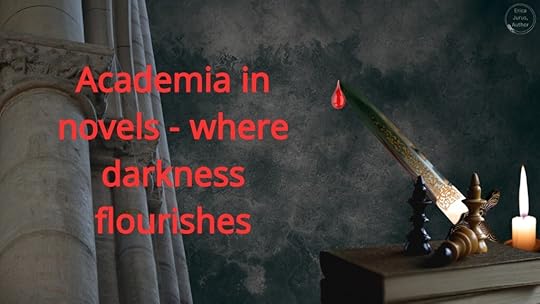
How many of you kind of miss the excitement and rush of returning to school in September? Maybe not very many, although I did for a long time. I loved going to school – not the day-to-day drudgery of homework, but the atmosphere of learning, of hanging out with friends, of a place where there was alternately shared fellowship and angst but ultimately, shared belonging.
Of course this wasn’t everyone’s experience, and apologies to anyone who had a very opposite one, but going to school during our most formative years leaves an indelible impression on us. I still have dreams about visiting my old elementary or secondary school; not sure why, but even decades later I can’t seem to escape their pull. Is that weird, or do you have them also?
From the years I spent working at a college, I can tell you that the bustle of back-to-school is viewed with both affection and dismay by staff. The first couple of weeks are insanity among the students – lined up for hours completing the class registrations they should have done in August, schlepping mounds of belongings into residence, wandering around aimlessly trying to get their bearings. The lack of parking space and general air of barely-controlled chaos breed a certain amount of camaraderie among staff – it’s all part of the special ecosystem that makes academia run.
Add to that all the personal dramas and people thrown into close proximity, and the stress of it all can erupt into some naughty behaviour. Novels set on campuses proliferate, tapping into those hotbeds of emotion and mystique – especially in what’s called ‘Dark Academia’, where shadows and intrigue, even murder or horror, lurk among the hallways.
 Exterior of one of the buildings at Trinity College in Dublin, Ireland – by E. Jurus, all rights reserved
Exterior of one of the buildings at Trinity College in Dublin, Ireland – by E. Jurus, all rights reservedSchools in campus novels are ‘cosy’, enclosed systems. It’s like being part of a special club. In fantasy and urban fantasy novels, this is taken to an extreme. In the popular YA paranormal romance series Vampire Academy, St. Vladimir’s Academy is not where any of us would end up. It’s where vampires go to study and their ‘dhampir’ guardians train to protect them. Rose Hathaway is the half-vampire/half-human dhampir, and her best friend Lissa Dragomir is a breed of vampire called the Moroi, who are generally ‘good guys’. But the vicious Strigoi – Moroi who’ve lost their humanity – are always recruiting, and Lissa and Rose struggle together to keep them at bay. All the usual drama is there, from jealousy, territorialism and scheming to, of course, both forbidden and unrequited love.
The Harry Potter series is one of the ultimate campus stories, centering around the titular character and the school, Hogwarts, where he goes to learn about the magic he’s been born with. But lest any novice readers think that the books would fall under “light academia” because they’re written about and for children, the world of Hogwarts has plenty of darkness. From the terrible wizard who tried to kill Harry as a baby and pursues him still, to the school House of Slytherin that attracts the students who like to play dirty, to the scary forest just beyond the school grounds, J.K. Rowling showed a realistic world where not everything was sunshine and picnics on the lawn.
Light and Dark Academia are themes, with associated moods and colours. You’ll find them all over Pinterest and Instagram if you take a look, but in novels they translate to the tone of the story and what transpires. Readers generally expect certain tropes when they pick up novels in either category.
Light Academia was developed as an antithesis to Dark Academia. Much like romance novels, the theme is “generally positive, focusing on optimism, sensitivity, joy, gratitude, friendship, motivation, and happy endings”. There are visuals that go with the mood: a lighter, cream-and-beige colour palette; cozy imagery; architecture that we tend to see on museums and prestigious college campuses. Even the fashion on the characters tends to reflect the theme – think softly ‘preppy’, with blazers, knit sweaters, pleated skirts, lots of tweed and linen.
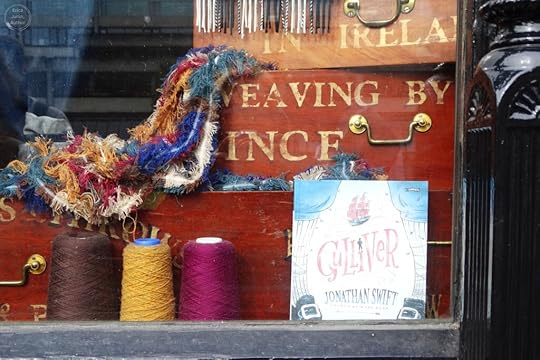 Window dressing of the Trinity College bookstore, Dublin, Ireland – by E. Jurus, all rights reserved
Window dressing of the Trinity College bookstore, Dublin, Ireland – by E. Jurus, all rights reservedDark Academia is more subversive. In some novels, the lightness on the surface hides wickedness underneath, as with Donna Tartt’s famous novel, The Secret History. The protagonist, Richard Papen, a student from a loveless California home, moves to Vermont to attend Hampden College, where he becomes fascinated by an avant-garde professor whose classes in Greek and the Classics are invitation-only. As Richard meets the few students that are in that group, he’s seduced by their exclusivity and perceived glamour. When he finally gains entrée, he finds that there’s an inescapable darkness inside.
There’s a definite air of danger in Dark Academia, whether it’s around murder, dark witchcraft, vampires and werewolves, or any number of imaginative threats that writers can come up with. When you think of these academic institutions, think darker and more saturated colours, Gothic architecture, hidden passageways, strange goings-on just out of sight, cultism, and all things murky and haunting.
Dark Academia overtly romanticizes the academic experience, where studying is done for the pure pleasure of it, in magnificent settings that make us envious of the people walking around in them. But there’s always some mischief taking place behind the fluted columns and gorgeous wooden book stacks.
 Venerable book stacks in the Trinity College Library, Dublin Ireland – by E. Jurus, all rights reserved
Venerable book stacks in the Trinity College Library, Dublin Ireland – by E. Jurus, all rights reservedOne of my personal favourites is an older novel called Tam Lin, by Pamela Dean. Janet begins studying at a local college, Blackstock, where her father is a professor. The setting is the 1970s, which was very familiar to me as a university student during the same time. Janet makes friends, has dates – all the usual parts of trying to grow up. But, as in the Scottish folk tale that this story is taken from, there are mysterious goings-on, especially among her male friends, who all seem to be under some kind of dark hold by one of their female professors, Professor Medeous, head of the Classics department.
Studying the Classics (Greek and Roman languages, literature, mythology and history) seems to be a favourite of Dark Academia – perhaps it’s the overwrought drama and fantastical stories from ancient times that create an atmosphere conducive to malevolence. After all, the original Grimm’s Fairy Tales were much darker than the Disney versions we grew up with.
Novels of Dark Academia are perfect reading in the weeks leading up to Halloween (only 58 days away). They draw us into their shadows and send chills up our spines. Time to make a cup of tea and sink yourself into the shadier side of schools, which we all suspected was there from the beginning 
If this is going to be your first foray into the ‘genre’, Book Riot offers a thoughtful list of books to get started with. And of course, my own novels are partially set in an obscure college where all kinds of things lurk. Have fun!
The post Academia in novels – where darkness flourishes first appeared on Erica Jurus.
August 27, 2024
The Green Dimension
 A walk in the woods – by E. Jurus, all rights reserved
A walk in the woods – by E. Jurus, all rights reservedDid you know that there’s a tree on the Earth that’s as old as the Pyramids? It’s a Bristlecone Pine in the White Mountains of eastern California that’s over 4,500 years old, and its name is “Methuselah”. The location of this venerable old tree is secret, to keep it safe from frickin’ idiots who’d either carve their names on it, or take its cones, or even benevolent photographers who could damage the fragile soil it grows in.
The Dawn Redwood species of tree, shown in the photo below, dates back about 150 million years. It was known in the fossil record before it was found alive on the planet. It’s a beautiful tree, with richly textured bark and remarkably soft, feathery needle-leaves. It’s now endangered.
 Taken at the Niagara Falls Botanic Garden – by E. Jurus, all rights reserved.
Taken at the Niagara Falls Botanic Garden – by E. Jurus, all rights reserved.One of the iconic trees in Africa, the Baobab, looks like it’s upside-down in the soil, like its roots are waving in the air. This tree grows in arid landscapes, which are common in the southern part of the continent. Remarkably, it can store up to 120,000 litres of water in its tree trunk.
 Baobabs do get leaves in the green season, as you’re seeing in this photo taken in Botswana – by E. Jurus, all rights reserved.
Baobabs do get leaves in the green season, as you’re seeing in this photo taken in Botswana – by E. Jurus, all rights reserved.Everyone loves bananas. (Fine, there might be a few curmudgeons that don’t, but that’s their loss  ). It turns out that these funky-looking fruit contain a natural chemical that makes people feel happy. To broaden their appeal, they’re so versatile – banana bread, sauteed bananas, banana pudding… Years ago at a destination wedding in Jamaica, I was in line in the resort’s lunch buffet, which featured a huge pan of bananas sauteed in butter and brown sugar. When I casually suggested to a friend behind me that I thought those lushly caramelized bananas would be delightful on top of some vanilla ice cream, he accused me of being the devil, for what I guess was enormous dessert temptation. Such is the power of the fruit trees give us.
). It turns out that these funky-looking fruit contain a natural chemical that makes people feel happy. To broaden their appeal, they’re so versatile – banana bread, sauteed bananas, banana pudding… Years ago at a destination wedding in Jamaica, I was in line in the resort’s lunch buffet, which featured a huge pan of bananas sauteed in butter and brown sugar. When I casually suggested to a friend behind me that I thought those lushly caramelized bananas would be delightful on top of some vanilla ice cream, he accused me of being the devil, for what I guess was enormous dessert temptation. Such is the power of the fruit trees give us.
 Bananas on a tree in the Amazon jungle – by E. Jurus, all rights reserved.
Bananas on a tree in the Amazon jungle – by E. Jurus, all rights reserved.The more urbanized we become, the more we tend to brush off the green in our lives as mere decoration – a few trees in planters along the streets, a few flowers that announce the entrance to a mall, grass that always needs cutting.
But if you, like me, love the aroma of freshly-cut grass, if it always makes you think of summertime and picnics, there’s a reason: the chemicals released from the cuttings relieve stress. They’re called green leaf volatiles, and researchers have found they can help to lower your blood pressure and heart rate, and reduce feelings of anxiety and fear.
The plants we often take for granted support all ecosystems on Earth. They support us. They bring enormous enrichment to our lives. They bring life.
 Iris means “rainbow” in Greek from the name for the goddess of the rainbow in Greek mythology; you can see her colours in this gorgeous bearded iris flower – by E. Jurus, all rights reserved
Iris means “rainbow” in Greek from the name for the goddess of the rainbow in Greek mythology; you can see her colours in this gorgeous bearded iris flower – by E. Jurus, all rights reservedThere are approximately 400,000 known plant species in the world, and it’s estimated that around 2,000 new plant species are discovered every year. Around 30,000 of those species are used in medicines that keep us alive and functional.
But we’re losing them rapidly. Over 570 plant species have ceased to exist since 1750 – twice the recorded number of bird, mammal and amphibian extinctions combined.
 Wild orchids, like this beauty I photographed in the Andean Cloud Forest, are among the many plants threatened by illegal trade, and habitat loss – by E. Jurus, all rights reserved.
Wild orchids, like this beauty I photographed in the Andean Cloud Forest, are among the many plants threatened by illegal trade, and habitat loss – by E. Jurus, all rights reserved.The colour green itself has a considerable effect on our well-being. Our eyes are especially sensitive to it because it falls in the middle of the visible spectrum, which makes easy to look at as well as calming to the mind. Its connection to plants and growth also symbolizes life, and renewal, to us.
 Yellow peony surrounded by shades of green – by E. Jurus, all rights reserved.
Yellow peony surrounded by shades of green – by E. Jurus, all rights reserved.Research has shown that exposure to green spaces, whether in forests or parks in our cities, can reduce stress levels, increase relaxation and improve our mood, and that people working in green environments are less fatigued, more focused and even more innovative.
In the dreary northern winter months, when we don’t get a lot of good-quality daylight, green environments can help with the effects of Seasonal Affective Disorder. During some of our worst, or longest winters that I can recall, I’ve spent some time hanging out at one of our local greenhouses to get a much-needed infusion of spring. You’ll often find me out at our botanic garden in March looking for fresh shoots of spring flowers bursting out among the drab landscape.
On the flip side, scientific evidence suggests that alienation from nature, called nature-deficit disorder’, contributes to a host of problems in both children and adults, including attention difficulties, emotional imbalance, and increased rates of obesity and physical illness.
And it’s not just the greenery that we love about being outdoors – it’s the animals that inhabit it. Studies have also shown that listening to birdsong decreases paranoia and anxiety (I love hearing the first spring bursts of song), and doctors in a number of countries have experimented with issuing “green prescriptions,” i.e. having patients spend more time outdoors. The results from this innovative (at least in modern eyes) therapy has shown positive mental and cardiovascular health benefits.
 Red Admiral butterfly on a lilac bush – by E. Jurus, all rights reserved
Red Admiral butterfly on a lilac bush – by E. Jurus, all rights reservedOf course, Indigenous peoples have understood this for a long time, as have the Japanese, who’ve been advocating ‘forest bathing’ for decades. Forest Bathing encourages people to engage all their senses, making a deep and mindful connection with the natural world.
I’ve blogged about some of this before, but with all the environmental anxiety around, it seemed to be a great time to point out our rather complacent, even dismissive, attitude to the stunningly gorgeous Green Dimension we still have access to, and are completely dependent on.
We get 60% of our energy intake from just three plant species: wheat, rice and maize. This is a dangerous position to be in, should a pest or disease wipe one or more of those out. In our modern time, two in every five wild plant species are threatened with extinction, reducing possible alternatives for our food supply.
 Luscious passion fruit cheesecake – by E. Jurus, all rights reserved.
Luscious passion fruit cheesecake – by E. Jurus, all rights reserved.Plants are rather brilliant beings, despite looking like they’re just standing around in the sun. For one thing, they ‘talk’ to each other – through their roots, using chemicals called ‘root exudates’ that inform neighbours in the same root zone how they’re doing. They can even share carbon with each other in the same way. They react to sound, such as music, and can sense the vibrations of water flowing underground to locate a water source.
Cells in plants’ roots and stems can detect the pull of gravity on their bodies – when a plant is tilted (as when they grow on a hillside, or out of the side of a wall or a cliff face), grains of starch within them shift around to tell the plant which way is up. When a plant is tilted, these starch grains shift from side to side, which stimulates hormones that tell the plant which way is up. The plants will make adjustments by elongating the cells on one side and shortening those on the other.
Plants and their lore are losing ground in our consciousness because we see ourselves as so separate from them. We even forget that without them we’d have no pollinators, no food, no shelter, no air to breathe – no life. I feel that’s why gardens, and in particular botanic gardens, are so important. I’ve learned so much just by exploring the several botanic gardens I’m so lucky to live in proximity to; the more I spend time photographing the plants, the more I’ve come to learn about and realize how special they all are, and what a treasure we have on our hands that we must not let go of.
 Pink water lilies on a garden pond – by E. Jurus, all rights reserved
Pink water lilies on a garden pond – by E. Jurus, all rights reservedMany people, myself included, believe in The Gaia hypothesis, which holds that our planet is a complex, self-regulating system, perhaps even an organism in its own right – one which works hard, just like our own bodies, to maintain conditions for life to continue.
The Gaia hypothesis was co-developed in the 1970s by a chemist named James Lovelock and a microbiologist named Lynn Margulis. Lovelock’s neighbour, novelist William Golding (Lord of the Flies), suggested that he name it after Gaia, the primordial deity who in Greek mythology personified the planet.
While working with the US space program, Lovelock had been developing ways for determining whether a planet could support life. He noted that living organisms naturally changed a planet’s atmosphere, and also how humanity was already dangerously changing Earth’s atmosphere.
Lovelock and Margulis proposed in their paper (Atmospheric homeostasis by and for the biosphere: The Gaia hypothesis) that “early after life began it acquired control of the planetary environment and that this homeostasis by and for the biosphere has persisted ever since.” Critics objected to the idea that life “manages” its environment, but I for one agree with it. We have only to look at how beautifully ecosystems run, from the tiniest to the largest, if humans aren’t interfering; look how many recovered during the Covid lock-downs (for example, reduced water pollution led to dolphins returning to many areas they’d stayed away from for more than a decade).
I think a lot about planets and ecosystems as I’m writing my novels, where the environment is deeply entwined with every setting, so along with just liking to breathe, I place a fair amount of importance on how plants and animals interact with each other.
 More than 20% of the world’s oxygen supply is produced by the Amazon Rainforest, seen in this dense tree canopy in Peru – by E. Jurus, all rights reserved
More than 20% of the world’s oxygen supply is produced by the Amazon Rainforest, seen in this dense tree canopy in Peru – by E. Jurus, all rights reservedSo what do we humans, ‘caretakers’ of the planet, do about this? Well, ‘Rewilding’ is increasing: the large-scale restoration of natural environments to increase biodiversity and reestablish viable ecosystems for wildlife.
If you’re a gardener on any scale, plant flowers and shrubs that provide nectar for bees, the single most critical pollinator on the planet. If I, who have zero talent for growing things, can have all kinds of bees buzzing around, anyone can do it.
 Not on a flower I’ve grown but one in a local garden, it’s a joy to see bees working away – by E. Jurus, all rights reserved.
Not on a flower I’ve grown but one in a local garden, it’s a joy to see bees working away – by E. Jurus, all rights reserved.I was inspired to write this post by a particular article I read on the subject, Seeing Green: Why We Should All Be Paying Attention to Plants, by Klaudia Khan: “Looking at plants and seeing them for what they truly are is like stepping into another realm or expanding our universe into another dimension: the green dimension.” I love that term, green dimension.
Given our modern state of ‘plant blindness’, we can work on realizing how important the Green Dimension really is. We need to truly love our plants, from the smallest and humblest to the most beautiful and majestic. We can spread awareness, help others to understand.
To that end, I’ve added a new page to my website called Green Dimension Photography (with all due respect and thanks to Klaudia for inspiring the name) to showcase the beauty all around us, if we just look for it, and I’m supporting an organization called Planet Wild who I believe does great work in ecosystem restoration. Once I get everything hooked up with my Fine Art America account, some of the photographs will be available to buy and hang in your own home, and all proceeds from those sales will go directly to Planet Wild.
If you’re interested in learning more about rewilding and our deep relationship with nature, you may want to check out the books by Vanessa Chakour, an author, nature advocate and rewilding facilitator, including Awakening Artemis: Deepening Intimacy with the Living Earth and Reclaiming our Wild Nature (2021) and Earthly Bodies: Embracing Animal Nature (coming September, 2024).
I hope my photographs give you a sense of both peace and wonder, and that they inspire you to spend more time in nature yourself. It’s all around us, but maybe not for long if we’re not careful. And please do feel free to comment either on this article or the photos, or both.
 Natural plant dyes used to colour llama and alpaca wool in Peru, handed down by generations – by E. Jurus, all rights reserved.
Natural plant dyes used to colour llama and alpaca wool in Peru, handed down by generations – by E. Jurus, all rights reserved.The post The Green Dimension first appeared on Erica Jurus.
August 20, 2024
On hiatus this week
 Photo of one of my favourite ponds at the Niagara Falls Botanic Garden – all rights reserved.
Photo of one of my favourite ponds at the Niagara Falls Botanic Garden – all rights reserved.I’m on hiatus this week while my laptop is being repaired. There will be a special post next week about the importance of plants in our world and the increasing phenomenon of ‘plant blindness’, where people ignore the ‘green dimension’ (a term I’m adopting from an ecological writer whose work I admire) that’s all around us. We can’t live without plants, literally — from the paper my novels are printed on to the food we eat and the oxygen we breathe. Your assignment in the meantime: pay attention to the wonderful world of green that you walk through all the time and that supports all life on earth. 
The post On hiatus this week first appeared on Erica Jurus.



